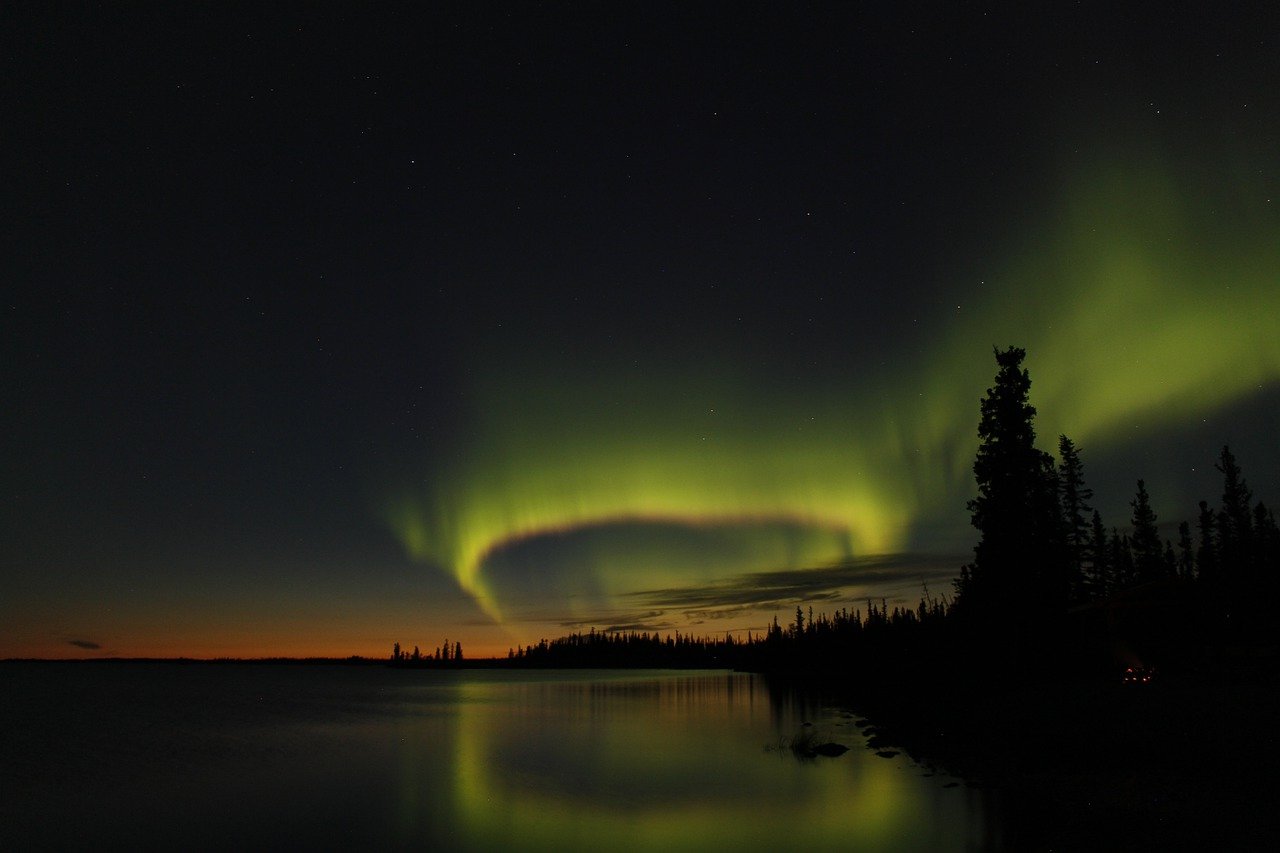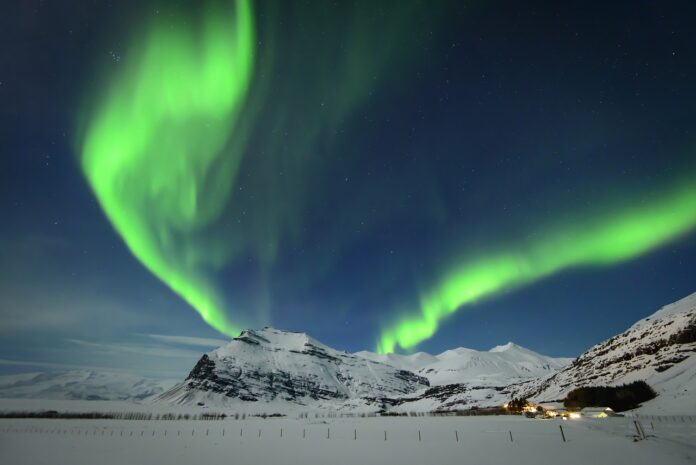The flickering colored lights in the sky on cold nights have long captivated people’s attention, and even today, many rush to northern regions to witness the spectacle. But what exactly are the Northern Lights, where and how can they be observed, and can they impact human beings? Let’s explore these questions in more detail.
How the Northern Lights Appear
The Northern Lights, or aurora borealis, are created when atoms and molecules in the upper layers of the atmosphere collide with charged particles emitted by the Sun (known as “solar wind”). The Earth’s core, primarily composed of iron, generates a magnetic field as it rotates, attracting these solar particles and directing them toward the Earth’s poles—hence the name “polar lights.” The peak intensity of the lights occurs every 11.5 years, corresponding to the solar cycle.
Where Can They Be Seen?
The main areas where the lights appear are near the North and South Poles (the Southern Lights occur over Antarctica). The phenomenon can last for an hour or even an entire day. In addition to polar regions, auroras can also be seen:
- In the U.S., Mexico, Canada, and Greenland (up to 200 times a year, including in summer);
- In northern Scandinavia, Iceland, and more vividly on the island of Svalbard;
- In parts of England and France (up to 10 times a year);
- In northern Florida (a few times a year);
- In Russia (Siberia, Kola Peninsula);
- In Scotland (mostly in spring).
The best time to observe the “heavenly illumination” is from mid-autumn to mid-winter, especially on cold nights when the lights are more visible.
Interesting Fact: Spacecraft have recorded auroras on other planets in the Solar System, including Venus, Mars, Jupiter, Uranus, and Neptune. On Saturn, the lights are particularly intense due to its much stronger magnetic field compared to Earth’s.
Types of Auroras
Scientists classify auroras based on the following characteristics:
Form
- Bands – Light streaks across the sky, sometimes in multiple layers.
- Spots – Aurora appearing as patches of light without a distinct shape.
- Rays – Thin beams of light shooting through the sky.
Color The color of an aurora depends on the altitude at which the particles collide and the chemical elements involved:
- Red auroras are formed at around 150 km altitude, when solar wind interacts with oxygen molecules.
- Yellow-green auroras appear at altitudes between 120-150 km and are the most common.
- Purple or blue hues occur when nitrogen is involved, usually at around 120 km altitude.
- White auroras are considered the rarest.
Fun Fact: The brightness and color of the aurora are linked to its intensity. Faint auroras (1 or 2 on a scale) are barely visible, while the most vivid auroras (3 or 4 on the scale) display bright, colorful lights.
Do Northern Lights Make a Sound?
Yes, they do! Eight years ago, Finnish scientists concluded that the auroras emit a quiet crackling, popping, or hissing sound at an altitude of about 70 km. They theorize that the sound is produced when the solar particles lose their charge in the Earth’s atmosphere.
Throughout history, people have not only admired the phenomenon but also tried to explain it using religious beliefs and scientific research.
Legends and Beliefs
Bright lights appearing suddenly in the night sky have spawned various mystical interpretations. In some cultures, the aurora was seen as a bad omen, while in others, it was a good one.
In Norse mythology, the Northern Lights were thought to be a bridge that allowed gods to descend to Earth. In other stories, it was said to be the glow of Valkyries’ armor—celestial warrior maidens—or the dancing souls of young women. The Finns believed the lights were “fox fires” or a fiery river dividing the upper and lower worlds.
People in Alaska feared that the aurora predicted impending disaster, and they wouldn’t leave their homes without weapons for protection. Ethnographers have also linked the aurora to myths of serpent-fighting heroes, which exist in different cultures.
Siberians and northern Russians invented many names for the lights, such as “pillars,” “beams,” “crimson,” “dawn lights,” and “whitewash.” Some northern Russian folklore claimed that crimson pillars in the sky were the prayers of righteous people rising to heaven.
Scientific Interest
In the 18th century, explorers like James Cook and Anthonio de Ulloa observed the aurora in the Southern Hemisphere and documented it, though they did not understand its cause. One explanation suggested that the glow came from fish decaying in massive quantities along the shores. Astronomer Edmond Halley was closer to the truth when he theorized that the Northern Lights were caused by “luminous magnetic fluid.”
The first scientist to link the aurora to electricity was Russian researcher Mikhail Lomonosov. He conducted experiments by passing electrical discharges through a glass sphere filled with low-pressure air and gas vapors, effectively “recreating” the Northern Lights in a lab. Lomonosov’s findings were later confirmed by other researchers who also discovered the interaction between charged particles and the Earth’s magnetic field.
In the 1970s, Soviet and French scientists used an electron gun to create artificial Northern Lights over the Indian Ocean. Their experiment opened new possibilities for studying the phenomenon in the near-Earth atmosphere.
Impact on Mental Health
In ancient times, it was noted that the Northern Lights sometimes caused people to behave unpredictably, even to the point of madness. During the polar night, people experienced melancholy, fits of rage, and sudden compulsions to run northward, seemingly obeying an unknown force. This “call of the Polar Star” or “merachenie” (as it was called in northern Russia) could spread through entire villages.
Some explorers, including Roald Amundsen, succumbed to this “polar madness” during their expeditions. Doctors accompanying these explorers confirmed that these episodes of “polar rage” coincided with peaks in auroral activity, particularly the red-colored displays.
Researchers found that the frequency of certain auroral pulsations closely matches the rhythm of the human brain, causing disturbances in its functioning. Additionally, the inaudible infrasound accompanying the aurora exerts unpredictable effects on the nervous system. Some scientists believe that frequencies around 7 Hz can be fatal.
Despite its mysterious and sometimes unsettling qualities, the beauty of the Northern Lights continues to captivate writers, filmmakers, artists, and tourists, drawing them irresistibly northward.
